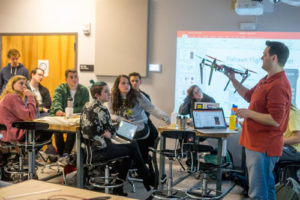Instead of solving for X or writing a thesis about information warfare, what if college students were designing drones that could solve the world’s declining oyster population? Or creating a way for U.S. intelligence agencies to counteract information warfare through social media?
That’s the idea behind James Madison University’s revolutionary JMU X-Labs program, which has undergraduate students solve authentic, real-world challenges for clients ranging from the Smithsonian Institution to the Department of Homeland Security and NATO.
Working in cross-disciplinary teams, students apply design-thinking strategies to solve complex challenges with important implications for health care, global safety, food security, and other weighty issues.
In the process, these students not only build deeper knowledge within academic disciplines such as science, engineering, and public policy; they also learn creative problem solving, teamwork, and other critical workforce skills—while making a difference in the world.
“I wish education was more like this,” says Cassandra Hagstoz, a JMU student who graduated last spring. “It’s so much more rewarding.”
JMU X-Labs consists of a dozen cross-disciplinary courses, including Drones, Community Innovations, Hacking for Diplomacy, and Medical Innovations. The courses are open to undergraduate students from any major, although they are advanced-level courses targeting juniors and seniors in particular.
Students in these courses meet with industry partners to discuss an authentic challenge they will solve, and they spend the rest of the semester working as a team to develop a solution. To support them in their work, the students have access to a state-of-the-art lab equipped with 3D printers, a laser cutter, virtual reality goggles, and other technologies.
The Drones course has challenged students to design and build drones that could identify and disarm landmines, find and rescue people lost at sea, and help solve ecological challenges, among other tasks.
For instance, a five-student Drones team this past spring designed an underwater drone that could create digital models of oyster reefs in the Chesapeake Bay to help reverse a 99-percent decline in the bay’s oyster population. With a detailed model of these reefs, scientists can build artificial reefs that are more effective in saving the oyster population. The student team consisted of physics, biology, industrial design, and writing majors.
A six-student team in the Hacking for Diplomacy class was challenged by the United States Special Operation Command (SOCOM) to create a way to monitor information warfare on various social media platforms, specifically in North Africa.
The students developed a Threat Escalation Model that gives U.S. intelligence agencies a way to identify and describe where countries are in the escalation of social movements. They also designed a way to collect data simultaneously from 30 social media platforms in more than 200 languages, allowing SOCOM to create searches and reports around certain keywords or relationships of interest—and they introduced SOCOM to bots as a means of counter-messaging.
The program is preparing students more effectively for the workplaces of today, where team-based problem solving is the norm.
“To talk with these students afterwards is amazing,” says Kim Fisher, director of communications for JMU X-Labs. “Going into the class, they’re terrified. When they come out, they’re like professionals. They’re getting hired earlier, and they’re getting paid more. They’re learning valuable skills that employers want.”
When the program first launched in 2015, the university struggled to find industry partners willing to participate.
“That was the tricky part: How do you convince professionals that an undergraduate student can help solve their problem in a way they can’t?” says Fisher. “In the beginning, it was an uphill climb. Now, we’ve gotten to the point where organizations are coming to us. They don’t have the time or resources to dig into these problems. But students do—and people have been so impressed with the results.”
The program has required faculty to shift their mindset as well, which was another challenge at first.
As Fisher says, “It’s a very humbling experience for them. They’re used to being the expert, and they come into these classes, and there’s a problem that NATO has provided and they don’t know the answer. The professors end up being more like guides or mentors. When students get stuck or feel totally overwhelmed, they get support from their instructors who can steer them in the right direction or refer them to certain resources.
“It’s flipping education on its head.”
- My Jerry Maguire summer - September 3, 2025
- Why ‘higher ed’ will thrive as it gets disrupted - September 1, 2025
- Tracking the AI evolution in higher ed: Lessons from four semesters of student data - August 29, 2025
